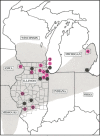Further evidence of Ceratobasidium D.P. Rogers (Basidiomycota) serving as the ubiquitous fungal associate of Platanthera leucophaea (Orchidaceae) in the North American tallgrass prairie
- PMID: 32297130
- PMCID: PMC7158956
- DOI: 10.1186/s40529-020-00289-z
Further evidence of Ceratobasidium D.P. Rogers (Basidiomycota) serving as the ubiquitous fungal associate of Platanthera leucophaea (Orchidaceae) in the North American tallgrass prairie
Abstract
Background: In the United States and Canada, ca. one-half of native orchid species are now threatened with extinction. A number of these species are restricted to tallgrass prairies of central North America, such as the Eastern Prairie Fringed Orchid, Platanthera leucophaea (Nutt.) Lindl.-a U.S. Federally threatened species.
Results: We provide new records of fungi recovered from roots of P. leucophaea and five other orchid species inhabiting prairie sites in Illinois and neighboring states during a 10-year period (2008-2017). A total of 39 fungal endophytes were isolated from Cypripedium candidum (1), Platanthera lacera (1), P. leucophaea (32), P. peramoena (3), Spiranthes lacera (1), and S. magnicamporum (1), 31 (79%) of which were assignable to Ceratobasidium and the remainder to Tulasnella. These fungi were acquired from 16 different sites, 13 of which are new records including two new state records (Iowa, Wisconsin). Molecular analysis revealed that some Ceratobasidium strains were virtually identical despite being geographically isolated by > 300 km.
Conclusions: This study, encompassing a decade of work, confirms that Platanthera leucophaea is a mycorrhizal specialist with heavy reliance on Ceratobasidium with the tallgrass prairie ecosystem of North America. Our isolation of Ceratobasidium from P. leucophaea spanning additional sites suggests that the association is widespread. Such information should provide conservationists and land managers with more confidence in developing protocols that facilitate the long-term conservation of this prairie orchid.
Keywords: Conservation; Endophytes; Mycorrhizal fungi; Specificity; Tulasnella.
Conflict of interest statement
The authors declare that they have no competing interests.
Figures


References
-
- Bell TJ, Bowles ML, Zettler LW (2016) Factors affecting survival, fecundity and population growth for a North American moth-pollinated prairie orchid (Platanthera leucophaea). In: Gale S (ed) Abstract Booklet—6th international orchid conservation congress, 16–22 May 2016. Hong Kong, Kadoorie Farm and Botanic Garden, 76.
-
- Bowles ML. The tallgrass prairie orchids Platanthera leucophaea (Nutt.) Lindl. and Cypripedium candidum Muhl. Ex Willd.: some aspects of their status, biology and ecology, and implications toward management. Nat Areas J. 1983;3(4):14–37.
-
- Bowles ML, Jacobs KA, Zettler LW, Wilson Delaney T. Crossing effects on seed viability and experimental germination of the Federal threatened Platanthera leucophaea (Orchidaceae) Rhodora. 2002;104:14–30.
Grants and funding
LinkOut - more resources
Full Text Sources

